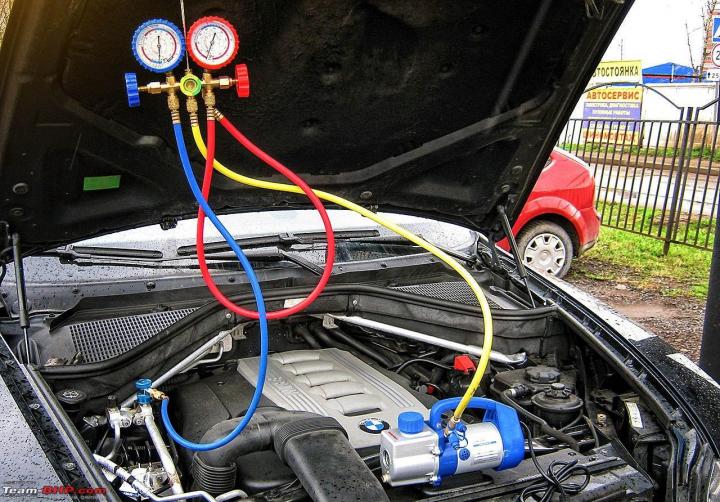To remove refrigerant from a car AC, it is important to follow specific steps to ensure safety and proper disposal of the refrigerant. Introducing refrigerant into the atmosphere can be harmful to the environment and is illegal in most jurisdictions.
Therefore, it is essential to remove the refrigerant properly before servicing the AC system. We will outline the steps you need to take to safely remove refrigerant from your car AC. By following these guidelines, you will not only protect the environment but also ensure that your AC system functions properly.
So, let’s dive in and learn how to remove refrigerant from your car AC in a responsible and efficient manner.

Credit: m.facebook.com
Tools And Equipment
When it comes to removing refrigerant from your car AC, having the right tools and equipment is essential. Not only will these tools help you effectively and safely remove the refrigerant, but they will also ensure that the process is done properly and according to the necessary guidelines.
Refrigerant Recovery Machine
A refrigerant recovery machine is a crucial tool for the job. This machine is designed to safely and efficiently remove the refrigerant from your car’s AC system. It works by creating a vacuum and drawing the refrigerant out of the system, storing it for later disposal. The machine is equipped with filters to remove any impurities, ensuring that the refrigerant is clean and ready for reuse or safe disposal.
Safety Goggles And Gloves
Wearing safety goggles and gloves is non-negotiable when it comes to handling refrigerant. Refrigerant is a hazardous substance that can cause harm if it comes into contact with your eyes or skin. Safety goggles protect your eyes from any accidental splashes or leaks, while gloves provide a barrier between your skin and the refrigerant. Make sure to choose goggles that fit snugly and provide full eye coverage, and select gloves that are resistant to chemicals.
Ac Gauges
AC gauges are essential for monitoring the pressure levels in your car’s AC system. These gauges allow you to determine the amount of refrigerant that needs to be removed and ensure that the pressure is maintained within safe limits. The gauges typically include high-pressure and low-pressure readings, enabling you to make adjustments as needed during the refrigerant removal process.
Refrigerant Tank
A refrigerant tank is used to store the recovered refrigerant. It is important to have a suitable tank that meets the necessary safety standards and regulations for refrigerant storage. The tank should be properly labeled and securely sealed to prevent any leaks or accidental releases. It is crucial to handle and dispose of the refrigerant in an environmentally responsible manner, following industry guidelines and regulations.
In conclusion, when removing refrigerant from your car AC, having the right tools and equipment is crucial. A refrigerant recovery machine, safety goggles, gloves, AC gauges, and a refrigerant tank are essential for a safe and successful refrigerant removal process.

Credit: www.pepboys.com
Step-by-step Process Of Safely Removing Refrigerant
Learn how to safely remove refrigerant from your car’s AC system with this step-by-step process. Follow these guidelines to ensure a smooth and efficient procedure.
Removing refrigerant from your car’s AC system is a necessary task when it comes to maintenance or repairs. However, it’s essential to follow a proper step-by-step process to ensure the safe handling of the refrigerant. In this guide, we will walk you through the entire procedure, from putting on safety gear to properly storing the refrigerant. So, let’s get started!Step 1: Put On Safety Gear
Before you begin the refrigerant removal process, it is crucial to prioritize your safety. Put on the necessary safety gear to protect yourself from any potential hazards. Here are some safety gear items you should have:- Gloves
- Safety goggles
- Face mask
- Protective clothing
Step 2: Connect The Ac Gauges
Once you have your safety gear on, it’s time to connect the AC gauges to the car’s AC system. The AC gauges allow you to measure the pressure and temperature of the refrigerant. Follow these steps to connect the AC gauges:- Locate the low-pressure port: It is usually located on the suction line of the AC system. Refer to your car’s manual if you are unsure about the exact location.
- Connect the blue hose: Attach the blue hose to the low-pressure port. This is the hose that measures the pressure of the refrigerant.
- Connect the red hose: Attach the red hose to the high-pressure port. This hose measures the temperature of the refrigerant.
- Secure the connections: Make sure the connections are tight to avoid any leaks during the refrigerant removal process.
Step 3: Hook Up The Refrigerant Recovery Machine
To safely remove the refrigerant, you will need a refrigerant recovery machine. This machine is specifically designed to extract the refrigerant from the AC system. Follow these steps to hook up the recovery machine:- Locate the service ports: The service ports are typically located near the AC compressor. Refer to your car’s manual for the exact location.
- Connect the recovery machine hoses: Attach the hoses of the recovery machine to the service ports. The machine should have separate hoses for input and output.
- Secure the connections: Ensure that the connections are properly secured to avoid any leakage of the refrigerant.
Step 4: Begin The Recovery Process
With the recovery machine set up, you can now start the refrigerant removal process. Follow the manufacturer’s instructions for your specific recovery machine, but the general steps include:- Switch on the recovery machine: Turn on the machine and allow it to stabilize.
- Start the recovery process: Initiate the recovery process on the machine’s control panel. The machine will begin extracting the refrigerant from the AC system.
- Monitor the process: Keep an eye on the gauges to ensure the proper extraction of the refrigerant. Follow the recommended recovery time provided by the machine’s manufacturer.
- Complete the recovery: Once the machine indicates that the recovery process is complete, stop the machine and proceed to the next step.
Step 5: Disconnect The Recovery Machine
After the refrigerant has been safely extracted from the AC system, it’s time to disconnect the recovery machine. Follow these steps to disconnect the machine:- Switch off the recovery machine: Turn off the machine to avoid any accidental leakage.
- Disconnect the recovery machine hoses: Remove the hoses from the service ports, making sure to do so carefully to avoid any refrigerant release.
- Secure the recovery machine: Properly store the recovery machine in a safe and appropriate location until its next use.
Step 6: Properly Store The Refrigerant
Properly storing the refrigerant is crucial to prevent any environmental harm and ensure future use. Follow these steps to store the refrigerant safely:- Identify the refrigerant container: The recovered refrigerant should be stored in an approved container. Look for a container specifically designed for refrigerant storage.
- Transfer the refrigerant: Carefully transfer the recovered refrigerant from the recovery machine to the storage container.
- Seal the container: Ensure that the storage container is tightly sealed to prevent any leakage.
- Label the container: Use a label to indicate the type of refrigerant stored and the date of recovery.
- Store in a safe location: Store the container in a cool, dry, and well-ventilated area away from any sources of ignition.

Credit: www.leaktracersdirect.co.uk
Conclusion
Removing refrigerant from your car’s AC system is a task that requires proper knowledge and caution. By following the steps outlined in this blog post, you can safely remove the refrigerant and ensure the smooth functioning of your car’s AC.
Remember to always prioritize your safety and consult a professional if needed. Taking care of your car’s AC system will not only enhance your comfort but also contribute to reducing environmental impact.

